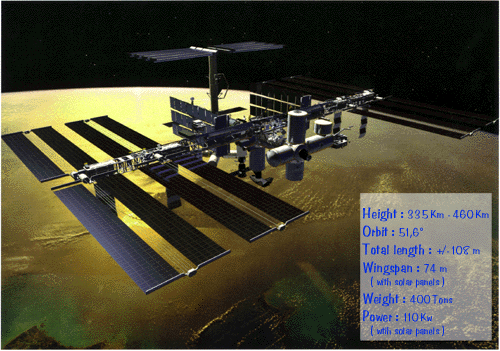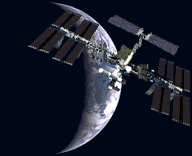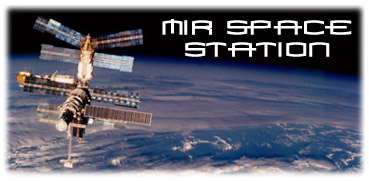
an orbital laboratory for long-term research, where
one of the fundamental forces of nature gravity is
a variable. In addition, worldwide research in biology,
chemistry, physics, ecology, and medicine can be
conducted using the most modem tools available.
Examples of the types of U.S. experiments that will
be performed aboard the ISS include:
Protein crystal studies: More pure protein crystals
will be grown in space than on Earth. Analysis of
these crystals helps us better understand the nature of
proteins, enzymes, and viruses, leading to the development
of new drugs and a better understanding of
the fundamental building blocks of life. Similar
experiments have been conducted on the Space
Shuttle, although they are limited by the short duration
of Shuttle flights. The ISS experiments will lead
to the study of possible treatments for cancer, diabetes,
emphysma, and immune system disorders,
among other research. This research is an example of
studies in the discipline of Biotechnology.
Tissue culture: Living cells are grown in a laboratory
environment in space where they are not distorted
by gravity. NASA already has developed a Bioreactor
device that is used on Earth to simulate, for such cul-
tures, the effect of reduced gravity. Still, these
devices are limited by gravity. Growing cultures for
long periods aboard the ISS will further advance this
research. Cultures will be used to test new treatments
for cancer without risking harm to patients. This
research is also in the field of Biotechnology.
Life in low gravity: The effects of long-term exposure
to reduced gravity on humans weakening muscles,
called atrophy; changes in work on the part of
the heart, arteries and veins, called reduced cardiovascular function;
and the loss of bone density;
among others will be studied aboard the ISS.
Studies of these effects will lead to a better understanding
of the body's systems and similar ailments
on Earth. A thorough understanding of such effects
and possible methods of counteracting them are needed
to prepare for future long-term human exploration
of the solar system. This research is in the field of
Biomedicine. In addition, studies of the gravitational
effects on plants, animals, and the function, of living
cells will be conducted aboard the ISS. A centrifuge,
located in the Centrifuge Accommodation Module,
will use centrifugal force to generate simulated gravity
ranging from almost zero to twice that of Earth.
This facility will imitate Earth's gravity for comparison
purposes; eliminate variables in experiments; and
simulate the gravity on the Moon or Mars for experiments
that can provide information useful for future
space travels. This research is in a field called
Gravitational Biology.
Flames, fluids, and metals in space: Fluids, flames,
molten metals, and other materials will be the subject
of basic research on the ISS. In a microgravity environment,
fluids are not subject to sedimentation and
buoyancy-driven convection (gravity-induced liquid
motion). This environment allows the study of forces
that are hidden by gravity and the resulting liquid
behavior. Research in this field is known as Fluid
Physics. Flames bum differently without gravity as
well. Reduced gravity reduces convection currents
the currents that cause wartn air or fluid to rise and
cool air or fluid to sink on Earth. This absence of convection
alters the flame shape in orbit and allows
studies of the combustion process that are impossible
on Earth, in a research field called Combustion
Science. The absence of convection allows molten
metals or other materials to be mixed more thoroughly
in orbit than on Earth. Scientists plan to study this
field, called Materials Science, to create better metal
alloys and more perfect materials for applications
such as computer chips. The study of all of these
areas Fluid Physics, Combustion Science, and
Materials Science may lead to developments that
can enhance many industries on Earth.
The nature of space: Some experiments aboard the
ISS will take place on the exterior of the ISS modules.
Such exterior experiments can study the space environment
and how long-term exposure to space, the
vacuum, and the debris affects materials. This
research, in the field of Space Science, can provide
future spacecraft designers and scientists a better
understanding of the nature of space and enhance
spacecraft design. Some experiments will study the
basic forces of nature, in a field called Fundamental
Physics, through which experiments take advantage of
niicrogravity to study forces that are weak and
difficult to study when subject to gravity on Earth.
Experiments in this field may help explain how the
universe developed. Investigations that use lasers to
cool atoms to near absolute zero may help us understand
gravity itself. In addition to investigating basic
questions about nature, Fundamental Physics research
could lead to down-to-earth developments that may
include clocks a thousand times more accurate than
today's atomic clocks, better weather forecasting, and
stronger materials.
 |
Watching the Earth: Observations of the Earth from orbit help the study of large-scale, long-term changes in the environment. Studies in this field, called Earth Science, will increase understanding of the forests, oceans, and mountains. The effects of volcanoes, ancient meteorite impacts, hurricanes, and typhoons can be studied. In addition, changes to the Earth that are caused by the human race also can be observed. The effects of air pollution, such as smog over cities; of deforestation, the cutting and burning of forests; and of water pollution, such as oil spills, are visible from space and can be captured in images that provide a global perspective unavailable from the ground. |
As part of the Commercialization of space research on
the ISS, industries will participate in ISS research by
conducting experiments and studies aimed at developing
new products and services. The results may benefit
those on Earth not only by providing innovative
new products as a result, but also by creating new
jobs to make the products,
Additional information is available over the World
Wide Web at http://station.nasa.gov/science/index.html
Or

-=Crew STS96=-
-=The ISS=-
 |
Media Player 28Ko / 56Ko
Real Video 28Ko / 56Ko |
